Energy and Water Saving Potential in Commercial Buildings: A Retrofit Case Study
Abstract
1. Introduction
2. Building Retrofit M&V
- Option A: performed for assessing the proper installation when equipment is changed. Engineering calculations are used to calculate the savings.
- Option B: performed at the device or system level after the completion of the project. The method to calculate the savings is also by engineering calculations.
- Option C: performed at the whole-building level to determine the savings using the pre-retrofit and post-retrofit utility meters’ data. The method to determine the savings range from simple comparison of the utility meters’ data to regression analysis.
- Option D: performed when savings are determined through energy simulations. Energy simulation tools are used to calculate the savings.
3. Energy and Water Consumption in Buildings in Saudi Arabia
4. Methodology
4.1. Case Study Description
4.2. Energy and Water Consumption
4.2.1. Energy Audit
- Walk-through survey of the facility.
- Data and information collection through meetings with the operator and occupants of the building.
- Space function analysis.
- Calculations/assessment of energy use for significant energy end-use categories.
- Identification of potential EEMs.
Total Power Consumption
Chillers’ Measurements
Indoor Temperature and Load Profiles
4.2.2. Building Water Consumption
- Annual water consumption: 18,720 Cubic Meter (m3).
- Annual Water cost: USD 26,122.17.
- Water cost/unit: USD 1.25/ m3.
- Maximum cost: USD 2255.4 in August.
- Minimum cost: USD 1742 in January.
- Water consumption index: 26.7 m3/m2/year.
4.2.3. Key Observations
- Constant flow chilled water circuit and 3-way valves are installed on the building side.
- Chillers operate at a low temperature difference of 3–4 °C.
- Chillers and pumps operate for 24 h.
- Chilled water set point temperature is maintained at 7 °C throughout the year.
- Existing CHIUs are provided with permanent split capacitor (PSC) motors. These motors are not controllable and they are always working at a constant speed (full load) and consume full power even if there is no demand.
- All OAUs are operating at full speed continuously for 24 h.
- There is no speed regulation system installed with the OAUs based on the climate or CO2 level in the indoor air.
- OAU filters were choked with dust.
- Most of the lights installed in the facility are FTL, CFL, and Halogen types. In common areas such as corridors, reception area, and praying hall, the lights are operating for almost 24 h.
4.3. Implemented Energy Efficiency Measures (EEMs) and Water Saving Measure
4.4. Cost Analysis
5. Results and Discussion
5.1. Savings Achieved by the EEMs
- Direct Savings
- Electricity savings (kWh) = present energy consumption—energy consumption with wet wall system).
- Cooling capacity improvement savings (kW) = present cooling capacity—wet wall cooling capacity).
- Indirect Savings
- Cost savings due to the chiller being under cover during non-operation times, dust-free condenser coil, and temperature data correction.
5.2. Whole-Building Energy Consumption
6. Conclusions and Future Work
- Investigate the use case of advanced M&V or “M&V 2.0” for the M&V of retrofitted buildings in the region. According to the Efficiency Valuation Organization’s (EVO) white paper [58], M&V 2.0 can be characterized by “using energy meter data in finer time scales with near real-time access, and Processing large volumes of data via advanced analytics”. M&V 2.0 will certainly lead to better results as already shown in a study that used a machine learning-supported methodology to conduct M&V 2.0 [59].
- Consider other M&V options for conducting the post-retrofit M&V including the other IPMVP options as well as the ASHRAE method. Each option is targeting different aspects of buildings; hence, to cover energy retrofitting M&V comprehensively, future studies need to apply the other options for the calculations.
- Identify and establish a decision-making process for energy retrofitting commercial office buildings. Currently, the rate of energy retrofitting of office buildings is almost negligible despite the advantages of energy retrofitting as presented in the case study in this study. One reason for the lagging behind in this area is that the effects of various factors on energy retrofitting such as building ownership type, tenants demands and perception of energy retrofitting, and real estate market location for office buildings is not known for the country. Such a study with policy implications is needed as presented in [60] for the United States.
- Expand on the case study building types, number of analyzed case studies, and the climatic location of the case studies in the country. Post-retrofitting M&V of residential, commercial, public, and governmental buildings in the country should also be presented. In addition, several case studies of all building types, including office buildings, are also necessary to validate energy retrofitting. Furthermore, the different climatic locations in the country should be covered in studies.
Author Contributions
Funding
Acknowledgments
Conflicts of Interest
References
- Ritchie, H.; Roser, M. Water Use and Stress. Available online: https://ourworldindata.org/water-use-stress (accessed on 17 June 2021).
- Koncagül, E.; Tran, M.; Connor, R. The United Nations World Water Development Report 2021: Valuing Water; Facts and Figures; UNESCO: Paris, France, 2021. [Google Scholar]
- Boretti, A.; Rosa, L. Reassessing the Projections of the World Water Development Report. NPJ Clean Water 2019, 2, 15. [Google Scholar] [CrossRef]
- Nejat, P.; Jomehzadeh, F.; Taheri, M.M.; Gohari, M.; Muhd, M.Z. A Global Review of Energy Consumption, CO2 Emissions and Policy in the Residential Sector (with an Overview of the Top Ten CO2 Emitting Countries). Renew. Sustain. Energy Rev. 2015, 43, 843–862. [Google Scholar] [CrossRef]
- IEA. Key World Energy Statistics 2019; IEA: Paris, France, 2019. [Google Scholar]
- Abergel, T.; Dean, B.; Dulac, J. Towards a Zero-Emission, Efficient, and Resilient Buildings and Construction Sector: Global Status Report 2017; UN Environment and International Energy Agency: Paris, France, 2017. [Google Scholar]
- Ahmed, W.; Asif, M. Energy Conservation and Management in Buildings. In The 4Ds of Energy Transition; Asif, M., Ed.; John Wiley & Sons, Ltd.: Hoboken, NJ, USA, 2022; pp. 247–266. [Google Scholar]
- Freedman, A. Climate Projections More Confident, Dire From IPCC|Climate Central. Available online: http://www.climatecentral.org/news/ipcc-report-shows-climate-scientists-more-confident-dire-in-projections-165 (accessed on 18 December 2017).
- Andrea Thompson Major Greenhouse Gas Reductions Needed by 2050: IPCC|Climate Central. Available online: http://www.climatecentral.org/news/major-greenhouse-gas-reductions-needed-to-curtail-climate-change-ipcc-17300 (accessed on 9 September 2022).
- DOE Retrofit Existing Buildings|Department of Energy. Available online: https://energy.gov/eere/buildings/retrofit-existing-buildings (accessed on 18 December 2017).
- BPIE Renovating the EU Building Stock|Buildings Performance Institute Europe. Available online: http://bpie.eu/focus-areas/renovating-the-eu-building-stock/ (accessed on 18 December 2017).
- Schlomann, B.; Isi, F.; Faberi, S.; Fioretto, I.M.; Piccioni, I.N.; Lechtenböhmer, I.S. Study on the Energy Savings Potentials in EU Member States, Candidate Countries and EEA Countries; Wuppertal Institut für Klima, Umwelt und Energie: Wuppertal, Germany, 2009. [Google Scholar]
- Liu, P.; Lin, B.; Zhou, H.; Wu, X.; Little, J.C. CO2 Emissions from Urban Buildings at the City Scale: System Dynamic Projections and Potential Mitigation Policies. Appl. Energy 2020, 277, 115546. [Google Scholar] [CrossRef]
- Jiang, J.; Ye, B.; Liu, J. Research on the Peak of CO2 Emissions in the Developing World: Current Progress and Future Prospect. Appl. Energy 2019, 235, 186–203. [Google Scholar] [CrossRef]
- Thomsen, K.E.; Rose, J.; Mørck, O.; Jensen, S.Ø.; Østergaard, I.; Knudsen, H.N.; Bergsøe, N.C. Energy Consumption and Indoor Climate in a Residential Building before and after Comprehensive Energy Retrofitting. Energy Build. 2016, 123, 8–16. [Google Scholar] [CrossRef]
- Jagarajan, R.; Abdullah Mohd Asmoni, M.N.; Mohammed, A.H.; Jaafar, M.N.; Lee Yim Mei, J.; Baba, M. Green Retrofitting—A Review of Current Status, Implementations and Challenges. Renew. Sustain. Energy Rev. 2017, 67, 1360–1368. [Google Scholar] [CrossRef]
- IEA. Electric Power Consumption (KWh per Capita)|Data. Available online: https://data.worldbank.org/indicator/EG.USE.ELEC.KH.PC (accessed on 9 September 2022).
- Alrashed, F.; Asif, M. Analysis of Critical Climate Related Factors for the Application of Zero-Energy Homes in Saudi Arabia. Renew. Sustain. Energy Rev. 2015, 41, 1395–1403. [Google Scholar] [CrossRef]
- Mahalik, M.K.; Babu, M.S.; Loganathan, N.; Shahbaz, M. Does Financial Development Intensify Energy Consumption in Saudi Arabia? Renew. Sustain. Energy Rev. 2017, 75, 1022–1034. [Google Scholar] [CrossRef]
- Abdul Mujeebu, M.; Alshamrani, O.S. Prospects of Energy Conservation and Management in Buildings—The Saudi Arabian Scenario versus Global Trends. Renew. Sustain. Energy Rev. 2016, 58, 1647–1663. [Google Scholar] [CrossRef]
- Government of Saudi Arabia. Saudi Arabia Vision 2030. 2016. Available online: https://en.wikipedia.org/wiki/Saudi_Vision_2030 (accessed on 9 September 2022).
- Al Surf, M.; Mostaafa, L. Will the Saudi’s 2030 Vision Raise the Public Awareness of Sustainable Practices? Procedia Environ. Sci. 2017, 37, 514–527. [Google Scholar] [CrossRef]
- Ahmed, W.; Asif, M. A Critical Review of Energy Retrofitting Trends in Residential Buildings with Particular Focus on the GCC Countries. Renew. Sustain. Energy Rev. 2021, 144, 111000. [Google Scholar] [CrossRef]
- Kim, D.B.; Kim, D.D.; Kim, T. Energy Performance Assessment of HVAC Commissioning Using Long-Term Monitoring Data: A Case Study of the Newly Built Office Building in South Korea. Energy Build. 2019, 204, 109465. [Google Scholar] [CrossRef]
- IPMVP Committee. International Performance Measurement and Verification Protocol: Concepts and Options for Determining Energy and Water Savings. Volume I. 2002. Available online: https://www.nrel.gov/docs/fy02osti/31505.pdf (accessed on 9 September 2022).
- Ginestet, S.; Marchio, D.; Morisot, O. Improvement of Buildings Energy Efficiency: Comparison, Operability and Results of Commissioning Tools. Energy Convers. Manag. 2013, 76, 368–376. [Google Scholar] [CrossRef]
- Ginestet, S.; Marchio, D. Retro and On-Going Commissioning Tool Applied to an Existing Building: Operability and Results of IPMVP. Energy 2010, 35, 1717–1723. [Google Scholar] [CrossRef]
- Newsham, G.R. Measurement and Verification of Energy Conservation Measures Using Whole-Building Electricity Data from Four Identical Office Towers. Appl. Energy 2019, 255, 113882. [Google Scholar] [CrossRef]
- Shin, M.; Baltazar, J.C.; Haberl, J.S.; Frazier, E.; Lynn, B. Evaluation of the Energy Performance of a Net Zero Energy Building in a Hot and Humid Climate. Energy Build. 2019, 204, 109531. [Google Scholar] [CrossRef]
- Deb, C.; Lee, S.E. Determining Key Variables Influencing Energy Consumption in Office Buildings through Cluster Analysis of Pre- and Post-Retrofit Building Data. Energy Build. 2018, 159, 228–245. [Google Scholar] [CrossRef]
- Jones, P.; Li, X.; Perisoglou, E.; Patterson, J. Five Energy Retrofit Houses in South Wales. Energy Build. 2017, 154, 335–342. [Google Scholar] [CrossRef]
- Hens, H. Energy Efficient Retrofit of an End of the Row House: Confronting Predictions with Long-Term Measurements. Energy Build. 2010, 42, 1939–1947. [Google Scholar] [CrossRef]
- Fu, H.; Baltazar, J.C.; Claridge, D.E. Review of Developments in Whole-Building Statistical Energy Consumption Models for Commercial Buildings. Renew. Sustain. Energy Rev. 2021, 147, 111248. [Google Scholar] [CrossRef]
- Asif, M. Growth and Sustainability Trends in the Buildings Sector in the GCC Region with Particular Reference to the KSA and UAE. Renew. Sustain. Energy Rev. 2016, 55, 1267–1273. [Google Scholar] [CrossRef]
- Alrashed, F.; Asif, M. An Exploratory of Residents’ Views Towards Applying Renewable Energy Systems in Saudi Dwellings. Energy Procedia 2015, 75, 1341–1347. [Google Scholar] [CrossRef]
- Ahmed, W.; Asif, M.; Alrashed, F. Application of Building Performance Simulation to Design Energy-Efficient Homes: Case Study from Saudi Arabia. Sustainability 2019, 11, 6048. [Google Scholar] [CrossRef]
- Nahiduzzaman, K.M.; Aldosary, A.S.; Abdallah, A.S.; Asif, M.; Kua, H.W.; Alqadhib, A.M. Households Energy Conservation in Saudi Arabia: Lessons Learnt from Change-Agents Driven Interventions Program. J. Clean. Prod. 2018, 185, 998–1014. [Google Scholar] [CrossRef]
- Krarti, M.; Howarth, N. Transitioning to High Efficiency Air Conditioning in Saudi Arabia: A Benefit Cost Analysis for Residential Buildings. J. Build. Eng. 2020, 31, 101457. [Google Scholar] [CrossRef]
- Al-Homoud, M.S.; Krarti, M. Energy Efficiency of Residential Buildings in the Kingdom of Saudi Arabia: Review of Status and Future Roadmap. J. Build. Eng. 2021, 36, 102143. [Google Scholar] [CrossRef]
- Ahmed, W.; Asif, M. BIM-Based Techno-Economic Assessment of Energy Retrofitting Residential Buildings in Hot Humid Climate. Energy Build. 2020, 227, 110406. [Google Scholar] [CrossRef]
- Krarti, M.; Aldubyan, M.; Williams, E. Residential Building Stock Model for Evaluating Energy Retrofit Programs in Saudi Arabia. Energy 2020, 195, 116980. [Google Scholar] [CrossRef]
- Krarti, M.; Dubey, K.; Howarth, N. Evaluation of Building Energy Efficiency Investment Options for the Kingdom of Saudi Arabia. Energy 2017, 134, 595–610. [Google Scholar] [CrossRef]
- Ahmed, W.; Fardan, H.; Asif, M. Integration of Building Energy Modeling in the Design Process to Improve Sustainability Standards in the Residential Sector—Case Study of the Eastern Province of Saudi Arabia. In Proceedings of the IEEE International Conference on Smart Energy Grid Engineering (SEGE), Oshawa, ON, Canada, 14–17 August 2017; pp. 309–314. [Google Scholar]
- Hamida, M.B.; Ahmed, W.; Asif, M.; Almaziad, F.A. Techno-Economic Assessment of Energy Retrofitting Educational Buildings: A Case Study in Saudi Arabia. Sustainability 2021, 13, 179. [Google Scholar] [CrossRef]
- Krarti, M.; Dubey, K. Energy Productivity Evaluation of Large Scale Building Energy Efficiency Programs for Oman. Sustain. Cities Soc. 2017, 29, 12–22. [Google Scholar] [CrossRef]
- Wali, F. The Future of Desalination Research in the Middle East. Nat. Middle East 2014. [Google Scholar] [CrossRef]
- FAO. World Water Resources by Country; FAO: Rome, Italy, 2015. [Google Scholar]
- KH, Z.; MS, A.-S.; Baig, M.B. Water Conservation in the Kingdom of Saudi Arabia for Better Environment. Bulg. J. Agric. Sci. 2011, 17, 389–395. [Google Scholar]
- Ouda, O.K.M. Towards Assessment of Saudi Arabia Public Awareness of Water Shortage Problem. Resour. Environ. 2013, 3, 10–13. [Google Scholar]
- Qadir, M.; Sharma, B.R.; Bruggeman, A.; Choukr-Allah, R.; Karajeh, F. Non-Conventional Water Resources and Opportunities for Water Augmentation to Achieve Food Security in Water Scarce Countries. Agric. Water Manag. 2007, 87, 2–22. [Google Scholar] [CrossRef]
- GASTAT. Per Capita Water Consumption in Saudi Regions during the Period 2009–2018. 2018. Available online: https://www.stats.gov.sa/sites/default/files/per_capita_water_consumption_in_saudi_regions_during_the_period_2009-2018.pdf (accessed on 9 September 2022).
- Baig, M.B.; Alotibi, Y.; Straquadine, G.S.; Alataway, A. Water Resources in the Kingdom of Saudi Arabia: Challenges and Strategies for Improvement. In Global Issues in Water Policy; Springer: Berlin/Heidelberg, Germany, 2020; Volume 23, pp. 135–160. [Google Scholar]
- Taleb, H.M.; Sharples, S. Developing Sustainable Residential Buildings in Saudi Arabia: A Case Study. Appl. Energy 2011, 88, 383–391. [Google Scholar] [CrossRef]
- Iqbal, I.; Al-Homoud, M. Parametric Analysis of Alternative Energy Conservation Measures in an Office Building in Hot and Humid Climate. Build. Environ. 2007, 42, 2166–2177. [Google Scholar] [CrossRef]
- Singh, M.; Singh, G.; Singh, H. Energy Audit: A Case Study to Reduce Lighting Cost. Asian J. Comput. Sci. Inf. Technol. 2013, 2, 119–122. [Google Scholar]
- ASHRAE. Procedures for Commercial Building Energy Audits, 2nd ed.; ASHRAE: Atlanta, GA, USA, 2011; ISBN 9781936504091. [Google Scholar]
- Thumann, A.; Younger, W.J. Handbook of Energy Audits, 7th ed.; Library of Congress: Washington, DC, USA, 2008; ISBN 0881735779.
- Webster, L.; Granderson, J.; Fernandes, S.; Crowe, E.; Earni, S. IPMVP’s Snapshot on Advanced Measurement & Verification. 2020. Available online: https://evo-world.org/images/corporate_documents/NRE-NRA_White_Paper_Final_2701.pdf (accessed on 9 September 2022).
- Gallagher, C.V.; Leahy, K.; O’Donovan, P.; Bruton, K.; O’Sullivan, D.T.J. Development and Application of a Machine Learning Supported Methodology for Measurement and Verification (M&V) 2.0. Energy Build. 2018, 167, 8–22. [Google Scholar] [CrossRef]
- Kontokosta, C.E. Modeling the Energy Retrofit Decision in Commercial Office Buildings. Energy Build. 2016, 131, 1–20. [Google Scholar] [CrossRef]
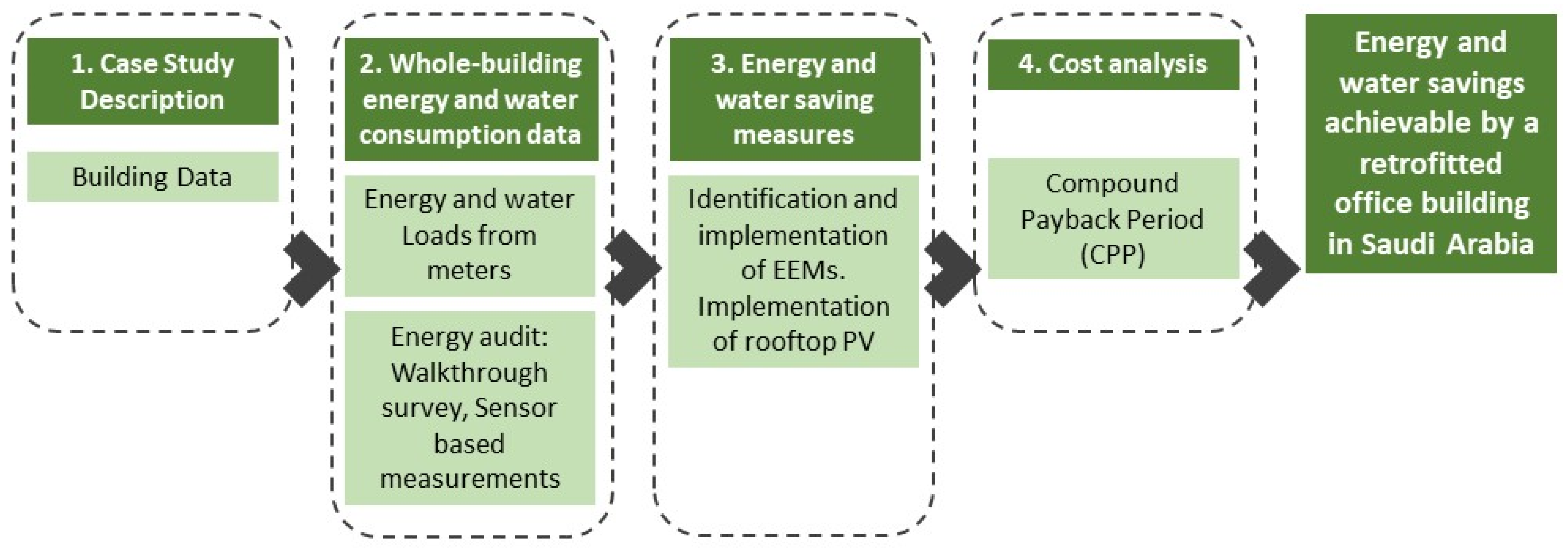

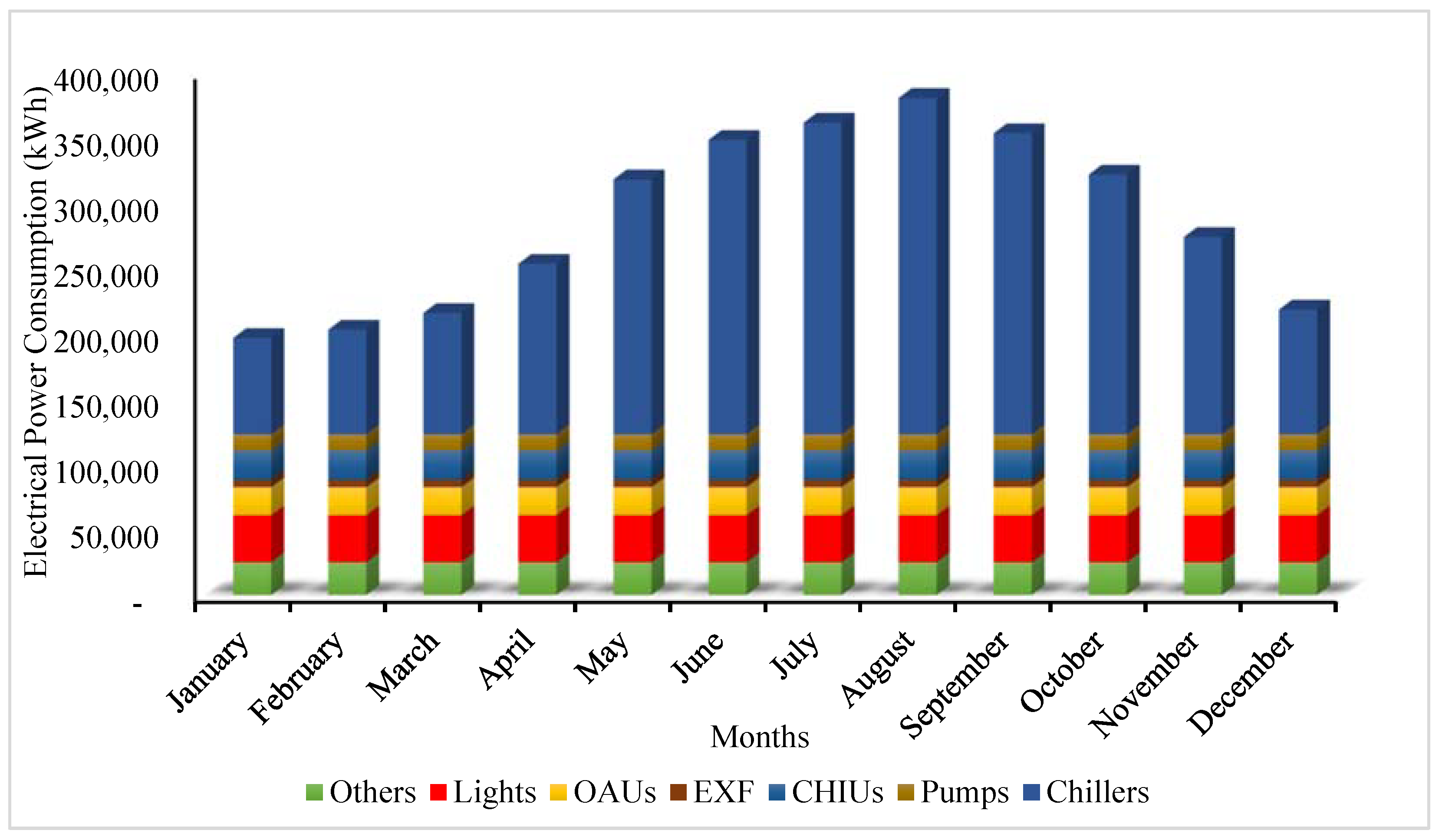
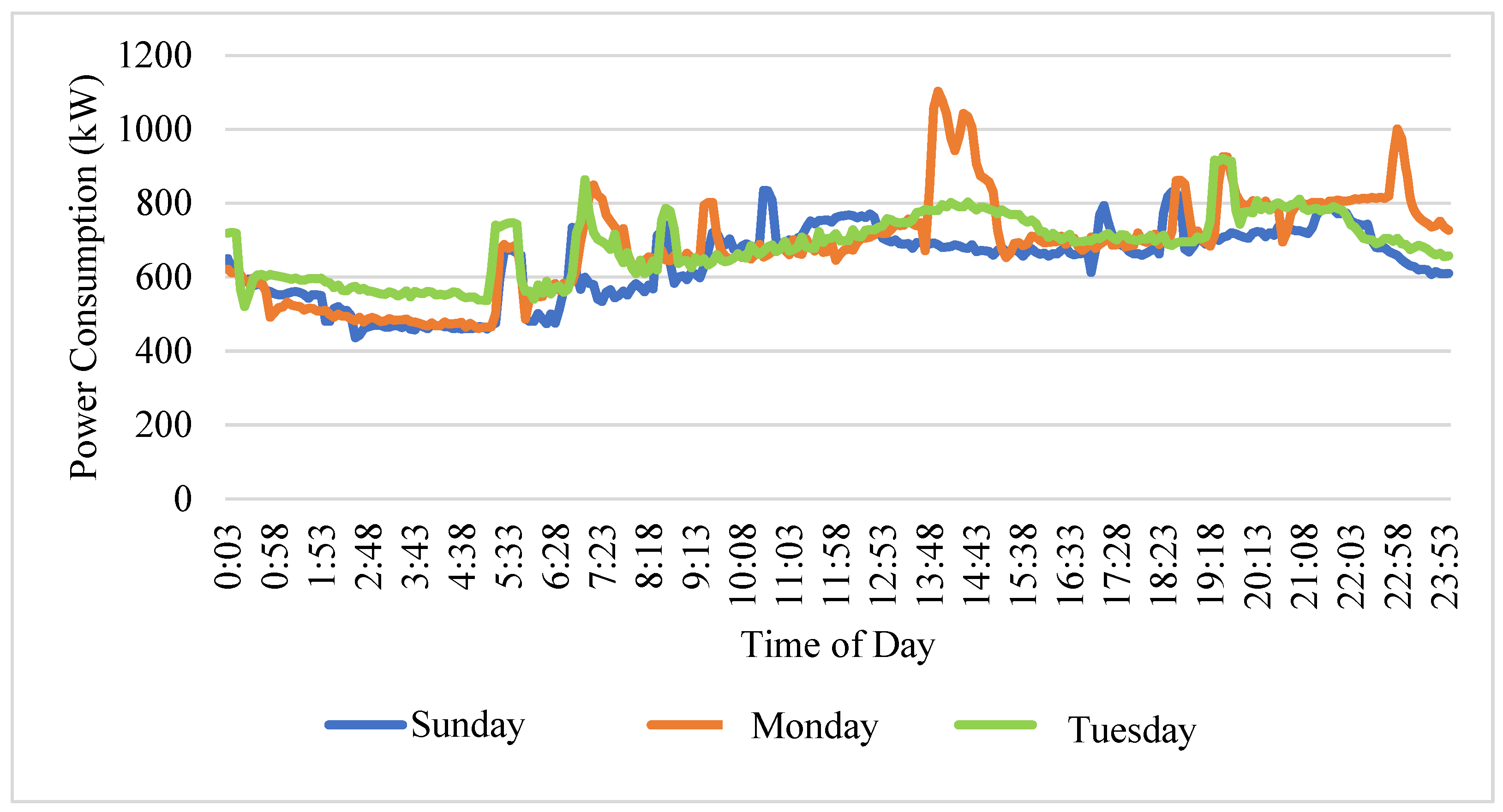
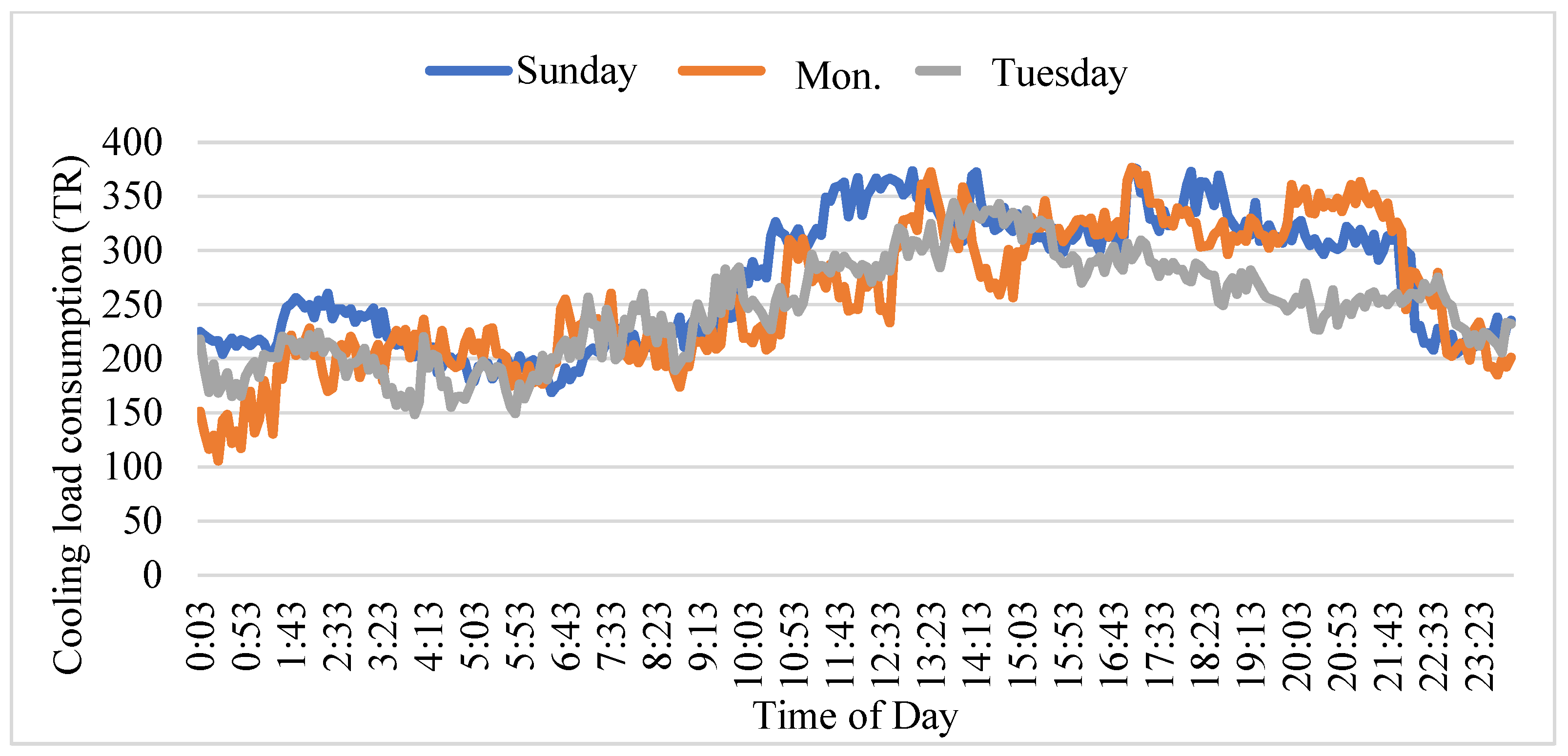

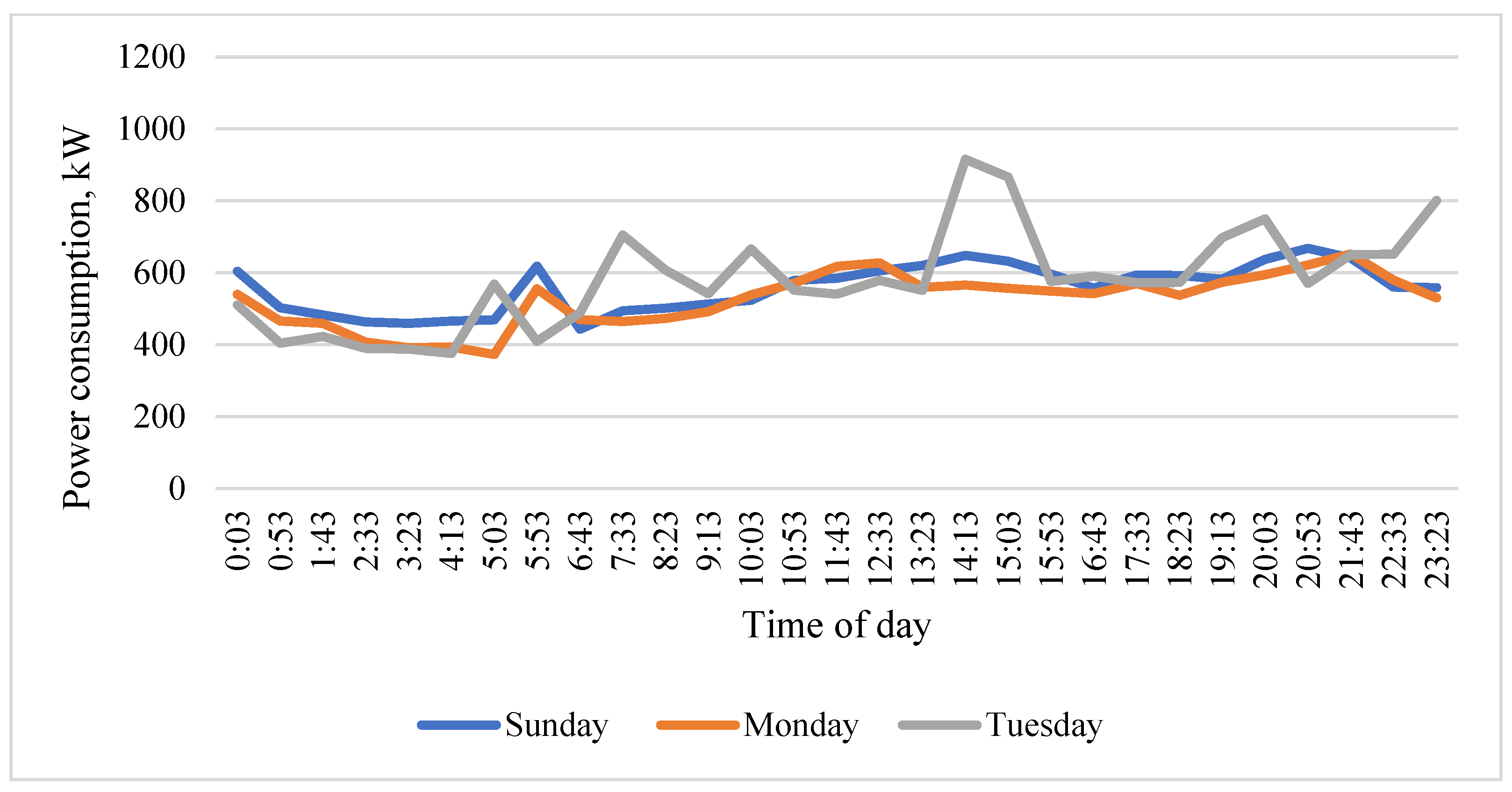
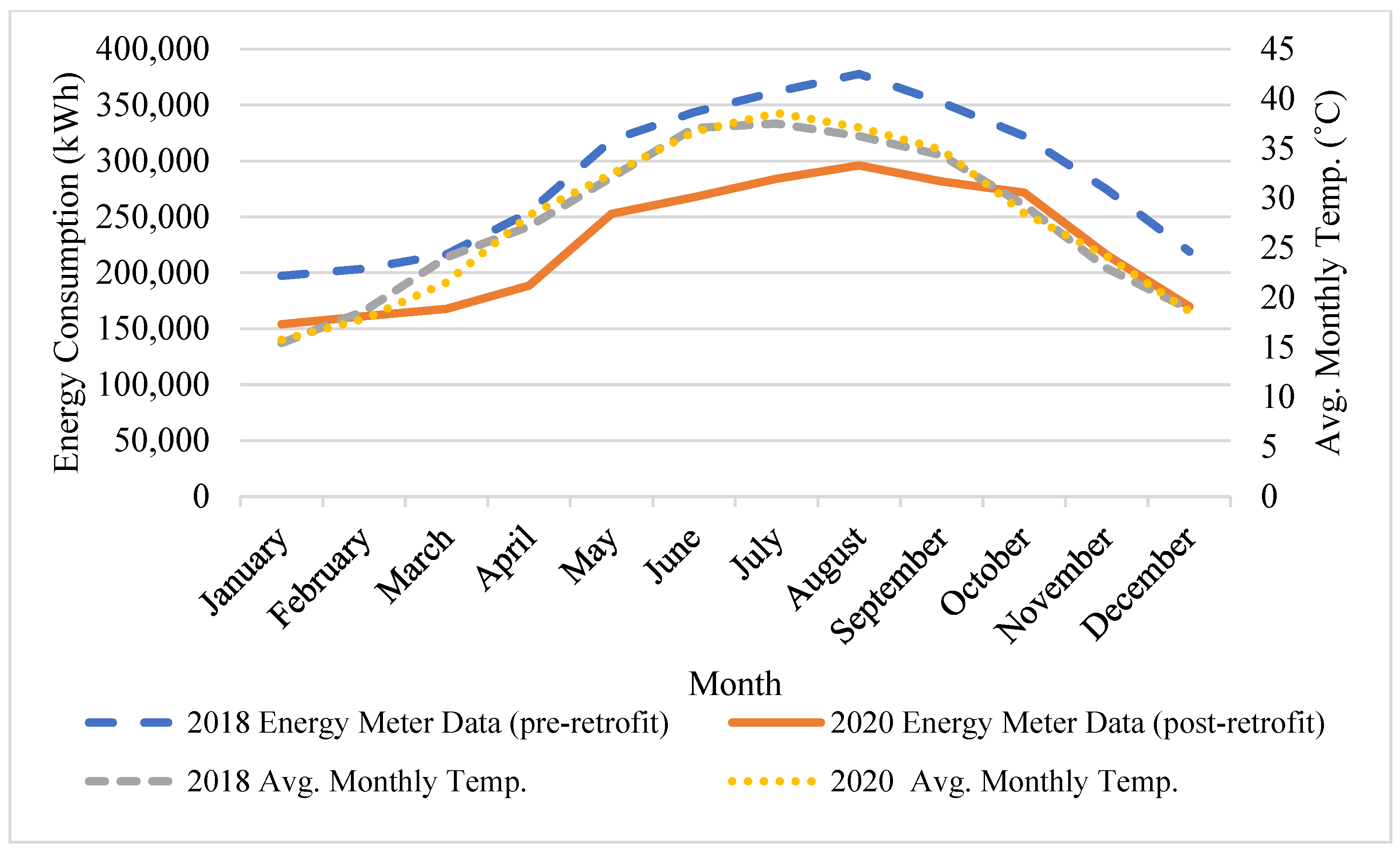
| Parameter | Description |
|---|---|
| Orientation | Southwest (longest side) |
| Occupants | 1000–1200 |
| Floor height | Slab to Slab: 4.1 m |
| No. of floors | Three |
| Total built area | 7500 m2 |
| Exterior walls | Brick face (4 inches)—Insulation (2 inches)—Concrete (4 inches) (U-Value = 0.51 W/m2 K). |
| Interior walls | Double face double layer of 16 mm thick (fire-rated gypsum boards and moisture resistant for wet area) with thermal isolation and paint. |
| Roof | 4-inch light weight Concrete Slab-½inch Roof (Asphalt roll)-8 Inch Reinforced Concrete Slab (1% steel), ½-inch Cement Plaster-Paint (U-Value = 0.45 W/m2 K) |
| Window to Wall (W–W) ratio | 32.67% |
| Glazing | Double Glazing 13 mm air space |
| Shading | None |
| Air Conditioning (AC) type/description | Chilled water system (chillers, air-handling units, primary pumps, exhaust fan, and fan coil units) |
| AC set point | 24 °C |
| Relative humidity | 50% |
| Lighting | Mixed (Florescent Tube Light, High Pressure Sodium, and Halogen) |
| Infiltration | Infiltration controlled with inside positive pressure |
| Energy Use Index (EUI) | 458.9 kWh/m2/year |
| Space | Temperature Range |
|---|---|
| Ground Floor Office (GF)-101 | Average temperature: 24.6 °C Maximum temperature: 25.9 °C Minimum temperature: 23.5 °C |
| GF-102 | Average temperature: 21.5 °C Maximum temperature: 25.1 °C Minimum temperature: 18 °C |
| First Floor (FF)-207 | Average temperature: 22.9 °C Maximum temperature: 24.1 °C Minimum temperature: 22.1 °C |
| Second Floor (SF)-103 | Average temperature: 22.3 °C Maximum temperature: 22.7 °C Minimum temperature: 21.8 °C |
| SF-105 | Average temperature: 24.8 °C Maximum temperature: 26.7 °C Minimum temperature: 23.1 °C |
| Staircase | Average temperature: 30.9 °C Maximum temperature: 33.5 °C Minimum temperature: 28.2 °C |
| GF-121 | Average temperature: 22.4 °C Maximum temperature: 23.1 °C Minimum temperature: 21.6 °C |
| Auditorium | Average temperature: 25.6 °C Maximum temperature: 27.9 °C Minimum temperature: 22.1 °C |
| No. | Measures | Description of Each Measure |
|---|---|---|
| 1 | Installing chiller plant manager with a smart control system. | An advance controller system used to control the operation of chillers was implemented. It offers energy saving features including dynamic resetting of chilled water supply temperature, proper scheduling/sequencing of the chiller based on dynamic cooling demand, return temperature and ambient temperature, demand limiting based on ambient/building load and history, matching number of pump operations with chiller operation, and monitoring and tracking of the plant performance through energy meter and power meter. The following is the scope of the smart control system: Replacing the existing chiller valve with a motorized valve. Field device installation, cabling. Trace chiller interface card. Design and program of the control system. |
| 2 | Installation of adiabatic cooling system for chillers (a retrofit solution that works based on the principle of adiabatic cooling system). | Air-cooled chiller performance depends on the ambient temperature. The higher the ambient temperatures, the lower the chiller efficiency. Adiabatic cooling system splashes water on the air that is used to cool the condenser. When water is exposed to air, it absorbs thermal energy from it, resulting in evaporation. As the air moves through the wet wall, the temperature drops, which in turn reduces discharge pressure in the refrigeration system (chiller) thereby, improving the chiller efficiency. It also helps to keep the condenser coil clean, which enhances the chiller efficiency further. |
| 3 | Installing ECM motors with Smart Thermostat for scheduling. | To make the CHIUs more efficient, the Electronically Commutated Motors (ECM) were used. These save energy and improve the efficient movement of air through the CHIU unit. |
| 4 | Scheduling of OAU through control system and Installation of Variable Frequency Drives (VFDs). | The OAU filters were cleaned and scheduled to be cleaned frequently. Furthermore, the amount of fresh air was regulated in order to reduce it and accordingly reduce the cooling capacity and power consumption. The VFDs were installed on the OAU to reduce the airflow to the required amount and reduce the power consumption through the fan and chiller. |
| 5 | Installation of Light Emitting Diode (LED) lights with Motion Sensors. | All identified existing FTLs, CFLs, and halogen lights were replaced with LED lights to reduce the lighting energy consumption. |
| 6 | Installation of water saving devices. | Installed new faucets with aerators for toilet and kitchen basins to reduce the water consumption. |
| Description | Value | Unit |
|---|---|---|
| Existing consumption | ||
| Chiller energy consumption | 1,971,449 | kWh |
| Total energy cost | 94,612.5 | USD |
| Savings calculation | ||
| % savings on Plant Manager | 7 | % |
| Electricity consumption savings | 137,642 | kWh |
| Cost savings | 6605.8 | USD |
| Investment | 41,325.9 | USD |
| CPP | 6.8 | Years |
| Description | Value | Unit |
|---|---|---|
| Existing consumption | ||
| Present energy consumption | 432,000 | kWh |
| Total cost | 20,732.25 | USD |
| Savings calculation | ||
| % of Savings on Lighting Load | 63.72 | % |
| Electricity consumption savings | 275,283 | kWh |
| Electricity cost savings | 13,211.2 | USD |
| Expenses | ||
| Investment | 23,995.7 | USD |
| Pay-back period | 1.9 | Years |
| Application | Present Flow | Post-Retrofit Flow | Annual Water Savings | Investment | Payback Period | |
|---|---|---|---|---|---|---|
| Liters Per Minute (LPM) | LPM | m3 | USD | USD | Years | |
| Wash basin | 7 | 4 | 2200 | 2756.6 | 7198.1 | 2.6 |
Disclaimer/Publisher’s Note: The statements, opinions and data contained in all publications are solely those of the individual author(s) and contributor(s) and not of MDPI and/or the editor(s). MDPI and/or the editor(s) disclaim responsibility for any injury to people or property resulting from any ideas, methods, instructions or products referred to in the content. |
© 2022 by the authors. Licensee MDPI, Basel, Switzerland. This article is an open access article distributed under the terms and conditions of the Creative Commons Attribution (CC BY) license (https://creativecommons.org/licenses/by/4.0/).
Share and Cite
Ahmed, W.; Alazazmeh, A.; Asif, M. Energy and Water Saving Potential in Commercial Buildings: A Retrofit Case Study. Sustainability 2023, 15, 518. https://doi.org/10.3390/su15010518
Ahmed W, Alazazmeh A, Asif M. Energy and Water Saving Potential in Commercial Buildings: A Retrofit Case Study. Sustainability. 2023; 15(1):518. https://doi.org/10.3390/su15010518
Chicago/Turabian StyleAhmed, Wahhaj, Ayman Alazazmeh, and Muhammad Asif. 2023. "Energy and Water Saving Potential in Commercial Buildings: A Retrofit Case Study" Sustainability 15, no. 1: 518. https://doi.org/10.3390/su15010518
APA StyleAhmed, W., Alazazmeh, A., & Asif, M. (2023). Energy and Water Saving Potential in Commercial Buildings: A Retrofit Case Study. Sustainability, 15(1), 518. https://doi.org/10.3390/su15010518






